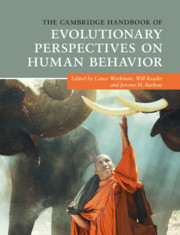Book contents
- The Cambridge Handbook of Evolutionary Perspectives on Human Behavior
- The Cambridge Handbook of Evolutionary Perspectives on Human Behavior
- Copyright page
- Dedication
- Contents
- Figures
- Tables
- Contributors
- Preface
- Acknowledgments
- Part I The Comparative Approach
- Part II Sociocultural Anthropology and Evolution
- Part III Evolution and Neuroscience
- Part IV Group Living
- Part V Evolution and Cognition
- 17 Runaway Processes in Modern Human Culture
- 18 Ontogeny of Tactical Deception
- 19 The Evolution of Language
- 20 The Adaptive Problem of Exploiting Resources
- Part VI Evolution and Development
- Part VII Sexual Selection and Human Sex Differences
- Part VIII Abnormal Behavior and Evolutionary Psychopathology
- Part IX Applying Evolutionary Principles
- Part X Evolution and the Media
- Index
- References
19 - The Evolution of Language
A Darwinian Approach
from Part V - Evolution and Cognition
Published online by Cambridge University Press: 02 March 2020
- The Cambridge Handbook of Evolutionary Perspectives on Human Behavior
- The Cambridge Handbook of Evolutionary Perspectives on Human Behavior
- Copyright page
- Dedication
- Contents
- Figures
- Tables
- Contributors
- Preface
- Acknowledgments
- Part I The Comparative Approach
- Part II Sociocultural Anthropology and Evolution
- Part III Evolution and Neuroscience
- Part IV Group Living
- Part V Evolution and Cognition
- 17 Runaway Processes in Modern Human Culture
- 18 Ontogeny of Tactical Deception
- 19 The Evolution of Language
- 20 The Adaptive Problem of Exploiting Resources
- Part VI Evolution and Development
- Part VII Sexual Selection and Human Sex Differences
- Part VIII Abnormal Behavior and Evolutionary Psychopathology
- Part IX Applying Evolutionary Principles
- Part X Evolution and the Media
- Index
- References
Summary
It is commonly assumed that expressive language is a secondary consequence of an abrupt change in human thought that emerged uniquely in humans within the past 100,000 years. This is difficult to reconcile with the theory of evolution by natural selection. An alternative view is that human thought evolved gradually over many millennia and has properties shared with other species. Some of these properties are critical to language; they include mental time travel, which underlies the linguistic properties of generativity and displacement, and theory of mind, which is critical to meaningful discourse. What does seem to be unique to humans is the ability to communicate our thoughts, rather than the nature of the thoughts themselves. Expressive language depended on the relatively late emergence of output systems flexible enough to map onto internal experience. I argue here that it was built first on manual gesture, with the gradual addition of vocalization.
- Type
- Chapter
- Information
- Publisher: Cambridge University PressPrint publication year: 2020



